Black Myth: Wukong is an impressive game from a technical standpoint, especially on PC where it delivers sumptuous visuals despite stutter and other performance issues. The PS5 version of the game offers a chance for developers Game Science to offer a more curated experience, yet baffling design choices and some visual cutbacks detract from what is otherwise a gripping game.
Those design choices start with the game’s modes, which come in three familiar flavours: quality, balance and performance. These three modes seem to offer nearly identical settings, with similar shadows and texture resolution, so the primary differences here come in terms of resolution and frame-rate targets.
The quality mode is perhaps the most straightforward, with roughly 1440p internal resolutions (we measured 1224p to 1584p) upscaled to 4K with FSR 3. This looks convincingly 4K-like in stills, but can come undone in motion – something that’s traditionally not FSR’s strong suit.
This is exacerbated by both the setting of the game – which features lots of transparencies like furry bosses – and dithered post-processing effects that make the game look speckly and messy in motion. Motion blur makes things even worse, but even with it disabled you’ll still notice issues with post-processed distortion effects on weapon hits.
Quality mode seems like it might want to target 30fps, but instead it tends to fluctuate between 31 and 36fps – truly bizarre. The frame-rate cap here either isn’t working, or is working in an extremely strange way.
The balance – not balanced – mode is next, and seems to use a 1080p internal resolution without upsampling or dynamic resolution. That gives it a softer resolve, with less visible detail and even worse dithering issues that remind me of halftone comic books. This mode targets 45fps within a 60Hz container, a kind of frame delivery no man’s land that reliably delivers judder as the game alternates between long and short frame-times. The only other time we’ve seen this is in the truly horrible port of Arkham Asylum in the Return to Arkham Collection on Xbox One X, and it makes just as little sense here.
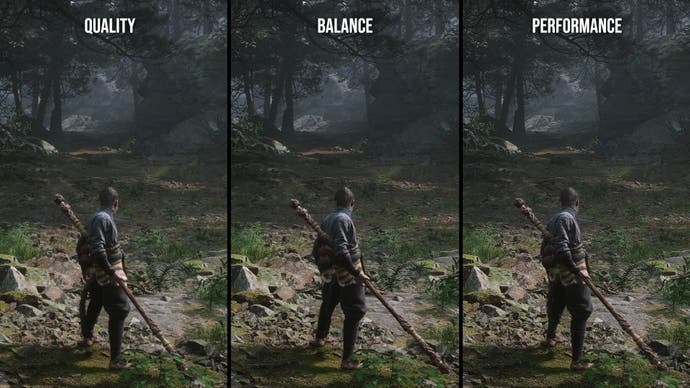
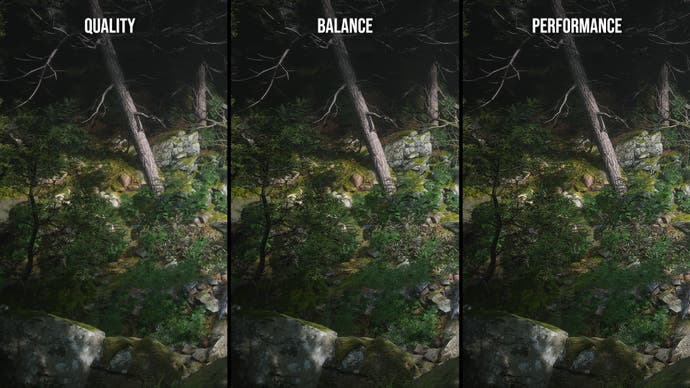
Performance mode is even weirder, as it uses the same fixed 1080p internal image, but the image has an incredibly strong sharpening filter that makes it look extremely crunchy, with a deep-fried look. Performance mode is also the only mode to use FSR 3 frame generation, which allows it to target 60fps – and achieve it most of the time, despite some (better-than-PC) traversal stutters and hard drops to 40fps in demanding scenes.
However, this comes at the cost of traditional frame generation artefacts around the borders of the screen, on particle effects and within UI elements, which are much more obvious than normal as the game is operating at such a low base resolution. Neither AMD nor Nvidia recommends using frame generation in this manner – Nvidia suggests a 40fps to 80fps conversion for a base level of quality, while AMD’s guidance revolves around an even more conservative 60fps to 120fps use case.
This puts the game in an uncomfortable place, as you’re getting the visual fluidity of 60fps, but with graphical artefacts and more input lag than you’d expect at 30fps – not ideal for an action game, even on played on gamepad.
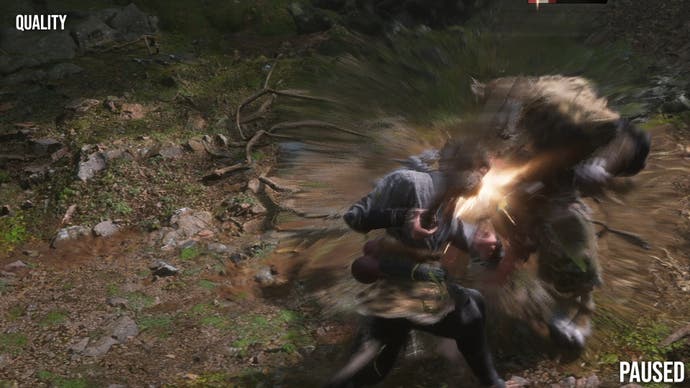
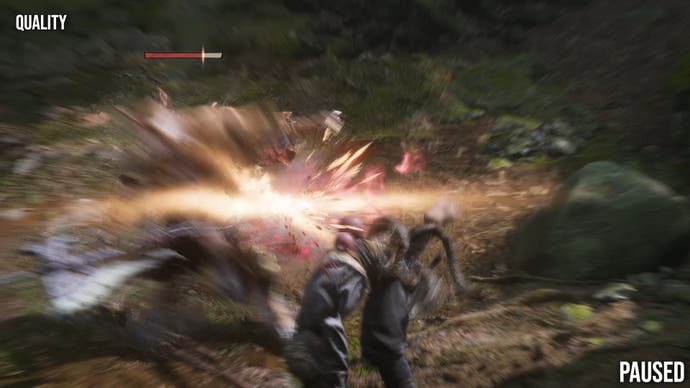
Game developers are able to use the PS5’s 120Hz and VRR support to improve otherwise shaky modes – but that hasn’t been done here. Neither technology is supported, which is a real shame as a 40fps balance mode in a 120Hz container with VRR would provide a much smoother experience than the current 45fps nightmare mode. You can forcibly enable VRR, but this doesn’t make a difference in the quality and balance modes because the game doesn’t consistently reach the minimum 48fps mark where VRR is active – and the performance mode is either at 60fps, where VRR isn’t needed, or at around 40fps, where it can’t be activated.
Overall, the 60fps performance mode is the best way to play the game, but none of the three modes feels well configured for the PS5, and significant improvements could be made to each.
It can be interesting to look at how PS5 games perform against PC, and in this case we’re specifically comparing the PS5 version to the PC version running at 4K with DLSS performance mode, no frame gen, cinematic settings and full ray tracing set to very high. You need a very fast rig for this, so is the PS5 able to deliver an appreciably similar experience at a fraction of the cost?
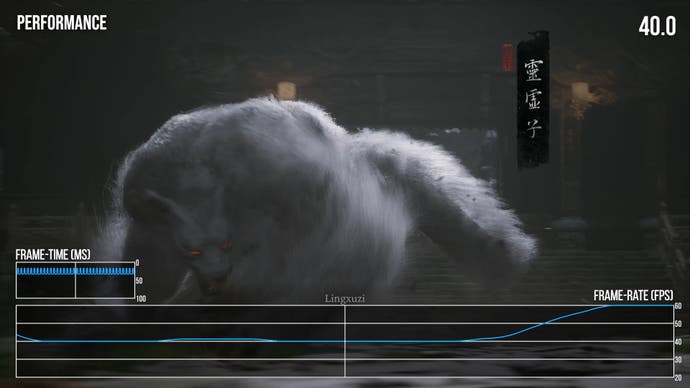
The opening moments of the game show several differences, from more dynamic and higher resolution volumetric simulation while fighting in clouds to more realistic shadows with variable penumbra, longer-range shadow coverage, more realistic indirect lighting that can brighten up some areas and better caustics and reflections in water. Alex’s Black Myth: Wukong PC tech review goes into greater detail about why the game looks so good at its maximum settings.
The game still does look reasonable on PS5, but this is one of a handful of PC titles that look significantly better with cranked to their maximum – even if you need something close to an RTX 4090 to still enjoy high frame-rates at such settings.
That shouldn’t take away from the PS5 version, which does look better than other Souls-like titles on PS5 in terms of its lighting, models, particles, animation and character designs. Even as an early UE5 game that switched from UE4 in the midst of development, it delivers a jaw-dropping level of visual quality in naturalistic environments with amazing materials and dense models. This is one of the best-looking games that we’ve seen all year.
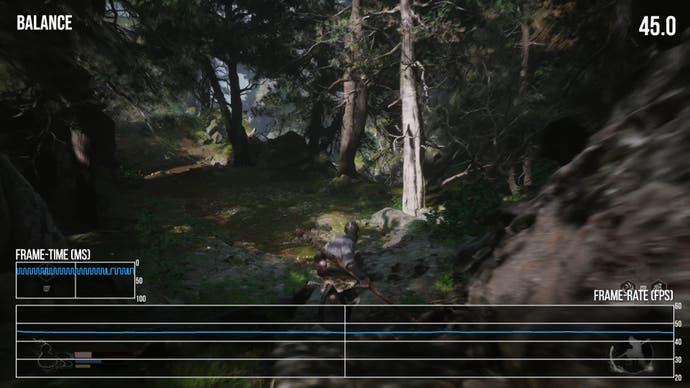
Ultimately then, the solutions Game Science has chosen for the PS5 version in terms of indirect lighting, reflections and shadows all work reasonably well – players aren’t being left behind on a feature level.
My concerns are more towards the game’s modes and performance. Frame-rates are not high in general, but the weird sharpening in performance mode, the bizarre FPS cap in balance mode and the broken frame-rate cap in quality mode are all clumsy own goals that could and should be fixed in time. Similarly, the deployment of frame generation still feels a bit strange, and the lack of 120Hz, VRR and even HDR support unnecessarily hobbles the game for owners of high-end displays.
It’s clear that Game Science has poured a lot of time and expertise into making a high-quality game, so I hope that these performance issues can be ironed out. My impression is that this is a PC-first release from developers that don’t have a lot of experience developing for PS5, because a lot of the conventions and concessions that console games typically use just aren’t here. Using UE5 probably does make achieving a good balance between performance and image quality more difficult, but there is certainly low-hanging fruit here that could substantially improve the experience in the here and now while more thorny issues are solved.




